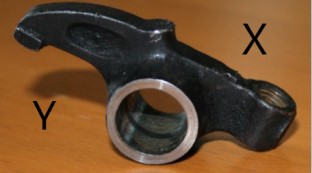Valve lift is the distance that the intake and exhaust valves move on the engine. This distance is controlled by the camshafts and it is crucial to the engine’s performance. Valve lift sometimes goes by gross lift but the terms are interchangeable.
The cam is a lobular shaft that opens and closes the valves as it rotates. The cam lift is defined as the distance the cam lobe rises outside of the base circle.
How To Calculate Valve Lift
Valve lift is fairly easy to calculate. All you need to know is your cam lift, provided by the manufacturer of the camshaft, and your rocker arm ratio. The rocker arm ratio is also easy to measure.
The rocker arm ratio is the distance from the center of the pivot point of the rocker arm to the center of the valve stem (call this dimension “y”) divided by the distance from the center of the pivot point to the center of the pushrod dimension “x”. So rocker arm ratio is equal to y/x.

To formula to calculate valve lift is simple.
Valve Lift = Cam Lift X Rocker Arm Ratio
Cam Lift = Valve Lift / Rocker Arm Ratio
As you can see its an easy calculations and the hardest part will be getting the cam lift information and rocker arm ratio measurements from your vehicle. Once you have that its a simple formula.
Why Is Valve Lift Important?
Valve lift is controlled by the lobes on the camshaft. The profile of the cam will determine the lift and the length of time that the valve stays open. Increasing your peak valve lift by changing out the camshaft allows for more air and fuel to enter into your engine.
If an engine has low peak valve lift, this will restrict the ability of the air/fuel mixture to flow into and out of the combustion chamber. For maximum engine power, a high peak valve lift number is desired. Increasing valve lift will increase max engine power output up until the valve clearance is no longer the bottleneck. Eventually other components will be the bottleneck in the airflow such as the cylinder head porting or manifold system.
However increasing valve lift does have side effects. Although the peak engine power could increase, the low end/low speed performance will suffer and the engine could feel much less torquey. That is why picking a valve lift for an engine is always a comprise between driveability and high-end power.
To avoid compromising many manufacturers have developed variable valve timing. This is a technology that changes the cam profile allowing a low peak valve lift at low rpms, but an aggressive high performance valve lift at high rpms for peak performance. To find out more on how this works, check out our article on variable valve timing here.
Intake Valve Opening
The camshaft profile is one of the most crucial components of an internal combustion engine. The profile controls the valve lift, opening time, closing time, and the duration that the valve is open for.
It is very crucial that the valve opens at the correct time. During regular operation, the intake and exhaust valve will have a brief period where they are open at the same time. However, if the intake valve opens too early, it can suck exhaust gases back into the combustion chamber. This lowers the potency of the next air fuel mixture in the combustion chamber hurting performance.
A late opening intake valve is great for a strong idle, but poor for high rpm operation. At higher rpms engines need more air and fuel to make power. To get more air into the cylinder the valve has to be open longer or the lift has to be higher. When selecting a camshaft it is very important to determine the rpm range that the engine will be operating in.
The closing timing of the intake valve has several affects on engine performance as well. An early intake valve closing is great for high crank pressure. This will translate into low-end torque and a broad powerband.
At higher rpms a later intake valve closing is preferred. This will allow as much air as possible to enter the combustion chamber. For peak performance, you would want the intake valve to close right as the fresh air stops rushing into the chamber.
Exhaust Valve Opening
Just like the intake valve, the exhaust valve opening time, closing time, valve lift, and duration is controlled by a camshaft. The exhaust valve has the least impact on engine performance but it is still important. The timing of the valve is important. Opening the exhaust valve too early, and the engine will lose torque from cylinder pressure escaping out the open exhaust valve rather than pushing the piston down.
Late exhaust valve opening helps the engine at low rpms and allows the engine to create torque by keeping pressure on the piston for a longer time. At high rpms, opening the exhaust valve earlier can improve scavenging of the combustion chamber
Camshaft Duration and Valve Lift
A cams duration has a huge affect on an engines responsiveness and drivability. A longer duration will improve the top end of the engine’s performance at the expense of the low end.
However a cam’s duration doesn’t tell you the whole story. The valve lift is a key piece of information. A short duration camshaft with a high valve lift will provide great power, torque, and responsiveness.
When picking a high valve lift camshaft there are considerations that need to be taken. A higher lift will require stronger valve springs. Another consideration is that the heads need to be able to provide adequate clearance for operation. Lastly the exhaust valves need to be able to flow adequate exhaust gases to accommodate the increased lift otherwise it could actually hurt the engines performance.
These considerations aside, a high lift camshaft can provide excellent performance and change the operating characteristics of the engine. The bottom line is that valve lift is a crucial metric to consider when comparing camshafts.




